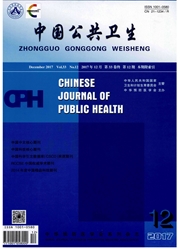

 中文摘要:
中文摘要:
目的研究心血管病家族史和超重在蒙古族人群中对缺血性脑卒中发生风险的联合效应。方法于2002年5月至2012年8月选择内蒙古通辽市科左后旗朝鲁吐苏木和奈曼旗固日班花苏木共32村作为研究现场,≥20岁以上的蒙古族居民共有3 475名;排除患慢性肾病、恶性肿瘤、甲状腺、肾上腺疾病以及急性传染性疾病者,最终纳入2 589名。平均随访了9.2年,6名因迁出而失访,随访率为99.8%。调查内容包括人口学资料、生活方式、饮酒史、吸烟史、个人疾病史、心血管病家族史等,以及体格检查,同时收集缺血性脑卒中的发病资料。将全部研究对象按照心血管病家族史和超重状况分为4组,以无心血管病家族史且BMI〈24 kg/m^2作为参照组,利用Cox比例风险回归模型分别计算其他3组缺血性脑卒中事件发生风险[HR(95%CI)]。结果 随访期间2 589名研究对象共发生缺血性脑卒中76例,其中,8名因缺少重要指标的数据而被剔除,最终共2 581名纳入分析,发病密度为323/10万人年。无心血管病家族史且BMI〈24 kg/m^2组、无心血管病家族史且BMI≥24 kg/m^2组、有心血管病家族史且BMI〈24 kg/m^2组和有心血管病家族史且BMI≥24 kg/m^2组的累积发病率分别为2.48%、1.86%、6.67%和9.00%。调整了年龄、性别、吸烟、饮酒、血糖、血压、TC、TG和心率因素后,多因素Cox比例回归模型分析显示,有心血管病家族史且BMI≥24 kg/m^2组发生缺血性脑卒中风险高于无心血管病家族史且BMI〈24 kg/m^2组,HR(95%CI)值为2.61(1.16-5.87);而其他两组即无心血管病家族史且BMI≥24 kg/m^2组和有心血管病家族史且BMI〈24 kg/m^2组与无心血管病家族史且BMI〈24 kg/m^2组缺血性脑卒中发病风险差异无统计学意义,HR(95%CI)值分别为1.18(0.58-2.39)、1.27(0.67-2.42)。结论 在蒙古族人群中,心血管病家族史和超重共存显著
 英文摘要:
英文摘要:
Objective To investigate the cumulative effect of family history of cardiovascular disease(CVD)and overweight on ischemic stroke events in the Mongolian population.Methods Study participants were recruited from 32 villages from May 2002 to August 2012 in Kezuohou Banner(county)and Naiman Banner in Inner Mongolia, China. Among 3 457 Mongolian people aged ≥20 years old living in these villages, 2 589 were selected to participate in this study. None of the participants had chronic kidney disease, malignant tumor, thyroid disease or adrenalopathy, or acute infectious disease. The 2 589 participants were followed for a mean of 9.2 years. Six participants were lost to follow up, resulting in a follow-up rate of 99.8%. Information collected included demographic characteristics, lifestyle risk factors, alcohol consumption, cigarette smoking, history of disease, family history of CVD, and physical examination. Ischemic stroke incidence information was collected during follow-up. All participants were categorized into four subgroups according to family history of CVD and overweight status. Cox proportional hazards models were used to estimate the hazard ratios(HR)and 95% CI of ischemic stroke events among subgroups, compared with the subgroup with no family history of CVD and body mass index(BMI)〈24 kg/m2(the reference group).Results Among 2 589 participants, 76 ischemic stroke events occurred after follow-up, and 8 were excluded because of lack of key data. Finally, 2 581 participants were included in the analysis, and the incidence density was 323/100 000 person-years. The cumulative incidence rates of ischemic stroke were 2.48%, 1.86%, 6.67% and 9.00% in the no family history of CVD and BMI 〈24 kg/m2, no family history of CVD and BMI ≥24 kg/m2, family history of CVD and BMI 〈24 kg/m2 and family history of CVD and BMI ≥ 24 kg/m2 subgroups, respectively. Using the Cox proportional hazards model, after further adjustment for age, gender, smoking, drinking, FPG, hypertension, total cholest
 同期刊论文项目
同期刊论文项目
 同项目期刊论文
同项目期刊论文
 Association of obesity and biomarkers of inflammation and endothelial dysfunction in adults in Inner
Association of obesity and biomarkers of inflammation and endothelial dysfunction in adults in Inner Association of elevated inflammatory and endothelial biomarkers with prehypertension among Mongolian
Association of elevated inflammatory and endothelial biomarkers with prehypertension among Mongolian Biomarkers of inflammation, endothelial dysfunction and insulin resistance in adults of Inner Mongol
Biomarkers of inflammation, endothelial dysfunction and insulin resistance in adults of Inner Mongol Relationship between white blood cell count at admission and short term outcome in patients with acu
Relationship between white blood cell count at admission and short term outcome in patients with acu Biomarkers of inflammation and endothelial dysfunction and risk of hypertension among Inner Mongolia
Biomarkers of inflammation and endothelial dysfunction and risk of hypertension among Inner Mongolia 期刊信息
期刊信息
